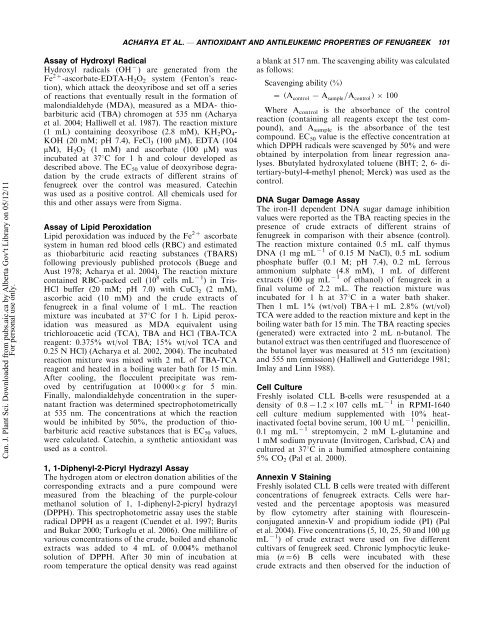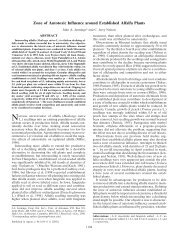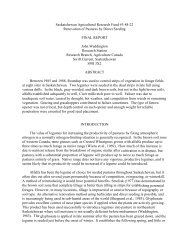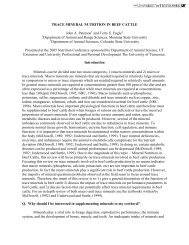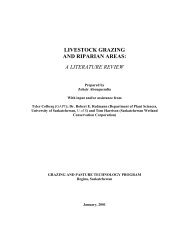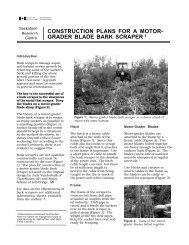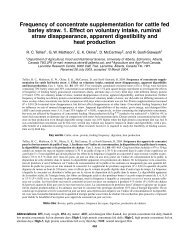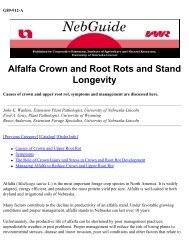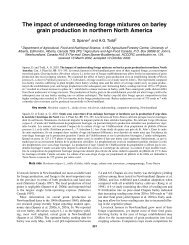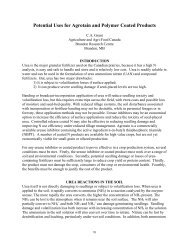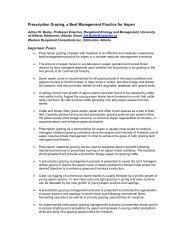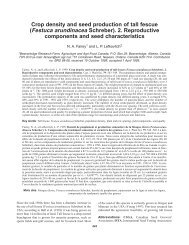Antioxidant and antileukemic properties of selected fenugreek ...
Antioxidant and antileukemic properties of selected fenugreek ...
Antioxidant and antileukemic properties of selected fenugreek ...
You also want an ePaper? Increase the reach of your titles
YUMPU automatically turns print PDFs into web optimized ePapers that Google loves.
Can. J. Plant Sci. Downloaded from pubs.aic.ca by Alberta Gov't Library on 05/12/11<br />
For personal use only.<br />
ACHARYA ET AL. * ANTIOXIDANT AND ANTILEUKEMIC PROPERTIES OF FENUGREEK 101<br />
Assay <strong>of</strong> Hydroxyl Radical<br />
Hydroxyl radicals (OH ) are generated from the<br />
Fe 2<br />
-ascorbate-EDTA-H2O2 system (Fenton’s reaction),<br />
which attackthe deoxyribose <strong>and</strong> set <strong>of</strong>f a series<br />
<strong>of</strong> reactions that eventually result in the formation <strong>of</strong><br />
malondialdehyde (MDA), measured as a MDA- thiobarbituric<br />
acid (TBA) chromogen at 535 nm (Acharya<br />
et al. 2004; Halliwell et al. 1987). The reaction mixture<br />
(1 mL) containing deoxyribose (2.8 mM), KH2PO4-<br />
KOH (20 mM; pH 7.4), FeCl3 (100 mM), EDTA (104<br />
mM), H2O2 (1 mM) <strong>and</strong> ascorbate (100 mM) was<br />
incubated at 378C for 1 h <strong>and</strong> colour developed as<br />
described above. The EC50 value <strong>of</strong> deoxyribose degradation<br />
by the crude extracts <strong>of</strong> different strains <strong>of</strong><br />
<strong>fenugreek</strong>over the control was measured. Catechin<br />
was used as a positive control. All chemicals used for<br />
this <strong>and</strong> other assays were from Sigma.<br />
Assay <strong>of</strong> Lipid Peroxidation<br />
Lipid peroxidation was induced by the Fe 2<br />
ascorbate<br />
system in human red blood cells (RBC) <strong>and</strong> estimated<br />
as thiobarbituric acid reacting substances (TBARS)<br />
following previously published protocols (Buege <strong>and</strong><br />
Aust 1978; Acharya et al. 2004). The reaction mixture<br />
contained RBC-packed cell (10 8 cells mL 1 ) in Tris-<br />
HCl buffer (20 mM; pH 7.0) with CuCl2 (2 mM),<br />
ascorbic acid (10 mM) <strong>and</strong> the crude extracts <strong>of</strong><br />
<strong>fenugreek</strong>in a final volume <strong>of</strong> 1 mL. The reaction<br />
mixture was incubated at 378C for 1 h. Lipid peroxidation<br />
was measured as MDA equivalent using<br />
trichloroacetic acid (TCA), TBA <strong>and</strong> HCl (TBA-TCA<br />
reagent: 0.375% wt/vol TBA; 15% wt/vol TCA <strong>and</strong><br />
0.25 N HCl) (Acharya et al. 2002, 2004). The incubated<br />
reaction mixture was mixed with 2 mL <strong>of</strong> TBA-TCA<br />
reagent <strong>and</strong> heated in a boiling water bath for 15 min.<br />
After cooling, the flocculent precipitate was removed<br />
by centrifugation at 10 000 g for 5 min.<br />
Finally, malondialdehyde concentration in the supernatant<br />
fraction was determined spectrophotometrically<br />
at 535 nm. The concentrations at which the reaction<br />
would be inhibited by 50%, the production <strong>of</strong> thiobarbituric<br />
acid reactive substances that is EC50 values,<br />
were calculated. Catechin, a synthetic antioxidant was<br />
used as a control.<br />
1, 1-Diphenyl-2-Picryl Hydrazyl Assay<br />
The hydrogen atom or electron donation abilities <strong>of</strong> the<br />
corresponding extracts <strong>and</strong> a pure compound were<br />
measured from the bleaching <strong>of</strong> the purple-colour<br />
methanol solution <strong>of</strong> 1, 1-diphenyl-2-picryl hydrazyl<br />
(DPPH). This spectrophotometric assay uses the stable<br />
radical DPPH as a reagent (Cuendet et al. 1997; Burits<br />
<strong>and</strong> Bukar 2000; Turkoglu et al. 2006). One millilitre <strong>of</strong><br />
various concentrations <strong>of</strong> the crude, boiled <strong>and</strong> ehanolic<br />
extracts was added to 4 mL <strong>of</strong> 0.004% methanol<br />
solution <strong>of</strong> DPPH. After 30 min <strong>of</strong> incubation at<br />
room temperature the optical density was read against<br />
a blankat 517 nm. The scavenging ability was calculated<br />
as follows:<br />
Scavenging ability (%)<br />
(Acontrol Asample =Acontrol ) 100<br />
Where Acontrol is the absorbance <strong>of</strong> the control<br />
reaction (containing all reagents except the test compound),<br />
<strong>and</strong> Asample is the absorbance <strong>of</strong> the test<br />
compound. EC50 value is the effective concentration at<br />
which DPPH radicals were scavenged by 50% <strong>and</strong> were<br />
obtained by interpolation from linear regression analyses.<br />
Bbutylated hydroxylated toluene (BHT; 2, 6- ditertiary-butyl-4-methyl<br />
phenol; Merck) was used as the<br />
control.<br />
DNA Sugar Damage Assay<br />
The iron-II dependent DNA sugar damage inhibition<br />
values were reported as the TBA reacting species in the<br />
presence <strong>of</strong> crude extracts <strong>of</strong> different strains <strong>of</strong><br />
<strong>fenugreek</strong>in comparison with their absence (control).<br />
The reaction mixture contained 0.5 mL calf thymus<br />
DNA (1 mg mL 1 <strong>of</strong> 0.15 M NaCl), 0.5 mL sodium<br />
phosphate buffer (0.1 M; pH 7.4), 0.2 mL ferrous<br />
ammonium sulphate (4.8 mM), 1 mL <strong>of</strong> different<br />
extracts (100 mg mL 1 <strong>of</strong> ethanol) <strong>of</strong> <strong>fenugreek</strong>in a<br />
final volume <strong>of</strong> 2.2 mL. The reaction mixture was<br />
incubated for 1 h at 378C in a water bath shaker.<br />
Then 1 mL 1% (wt/vol) TBA 1 mL 2.8% (wt/vol)<br />
TCA were added to the reaction mixture <strong>and</strong> kept in the<br />
boiling water bath for 15 min. The TBA reacting species<br />
(generated) were extracted into 2 mL n-butanol. The<br />
butanol extract was then centrifuged <strong>and</strong> fluorescence <strong>of</strong><br />
the butanol layer was measured at 515 nm (excitation)<br />
<strong>and</strong> 555 nm (emission) (Halliwell <strong>and</strong> Gutteridege 1981;<br />
Imlay <strong>and</strong> Linn 1988).<br />
Cell Culture<br />
Freshly isolated CLL B-cells were resuspended at a<br />
density <strong>of</strong> 0.8 1.2 107 cells mL 1 in RPMI-1640<br />
cell culture medium supplemented with 10% heatinactivated<br />
foetal bovine serum, 100 U mL 1 penicillin,<br />
0.1 mg mL 1 streptomycin, 2 mM L-glutamine <strong>and</strong><br />
1 mM sodium pyruvate (Invitrogen, Carlsbad, CA) <strong>and</strong><br />
cultured at 378C in a humified atmosphere containing<br />
5% CO2 (Pal et al. 2000).<br />
Annexin V Staining<br />
Freshly isolated CLL B cells were treated with different<br />
concentrations <strong>of</strong> <strong>fenugreek</strong>extracts. Cells were harvested<br />
<strong>and</strong> the percentage apoptosis was measured<br />
by flow cytometry after staining with flouresceinconjugated<br />
annexin-V <strong>and</strong> propidium iodide (PI) (Pal<br />
et al. 2004). Five concentrations (5, 10, 25, 50 <strong>and</strong> 100 mg<br />
mL 1 ) <strong>of</strong> crude extract were used on five different<br />
cultivars <strong>of</strong> <strong>fenugreek</strong>seed. Chronic lymphocytic leukemia<br />
(n 6) B cells were incubated with these<br />
crude extracts <strong>and</strong> then observed for the induction <strong>of</strong>


